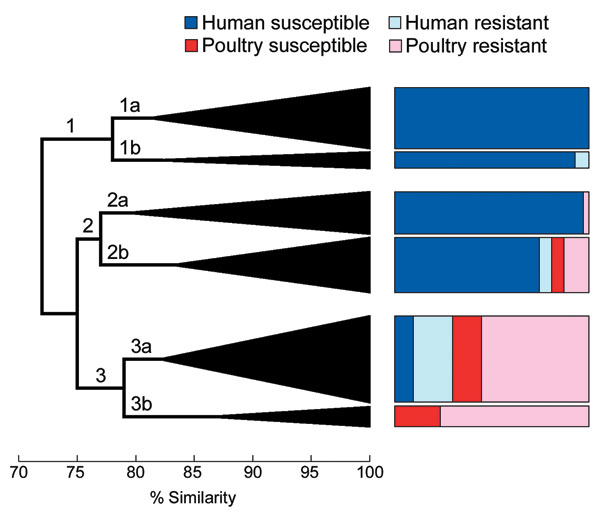Antimicrobial Drug–Resistant Escherichia coli from Humans and Poultry Products, Minnesota and Wisconsin, 2002–2004
James R. Johnson*†

, Mark R. Sannes*†
1, Cynthia Croy*†, Brian Johnston*†, Connie Clabots*†, Michael A. Kuskowski*†, Jeff Bender‡, Kirk E. Smith§, Patricia L. Winokur¶#, and Edward A. Belongia**
Author affiliations: *Minneapolis Veterans Affairs Medical Center, Minneapolis, Minnesota, USA; †University of Minnesota, Minneapolis, Minnesota, USA; ‡University of Minnesota, Saint Paul, Minnesota, USA; §Minnesota Department of Health, Saint Paul, Minnesota, USA; ¶University of Iowa, Iowa City, Iowa, USA; #Iowa City Veterans Affairs Medical Center, Iowa City, Iowa, USA; **Marshfield Clinic Research Foundation, Marshfield, Wisconsin, USA;
Main Article
Figure 3

Figure 3. Dendrogram based on extended virulence profiles of 243 extraintestinal pathogenic Escherichia coli isolates from human feces and poultry products, Minnesota and Wisconsin, 2002–2004. The dendrogram (shown here in simplified form) was constructed by using the unweighted pair group method with arithmetic averages based on pairwise similarity relationships according to the aggregate presence or absence of 60 individual virulence genes plus phylogenetic group (A, B1, B2, D). Triangles indicate arborizing subclusters. Major clusters 1, 2, and 3, and subclusters 1a, 1b, 2a, 2b, 3a, and 3b are indicated. Colored boxes to right of dendrogram show the distribution (by source group) of constituent members of each subcluster. Resistant, resistant to trimethoprim-sulfamethoxazole, nalidixic acid (quinolones), and ceftriaxone or ceftazidime (extended-spectrum cephalosporins). Susceptible, susceptible to all these agents.
Main Article
Page created: July 01, 2010
Page updated: July 01, 2010
Page reviewed: July 01, 2010
The conclusions, findings, and opinions expressed by authors contributing to this journal do not necessarily reflect the official position of the U.S. Department of Health and Human Services, the Public Health Service, the Centers for Disease Control and Prevention, or the authors' affiliated institutions. Use of trade names is for identification only and does not imply endorsement by any of the groups named above.
